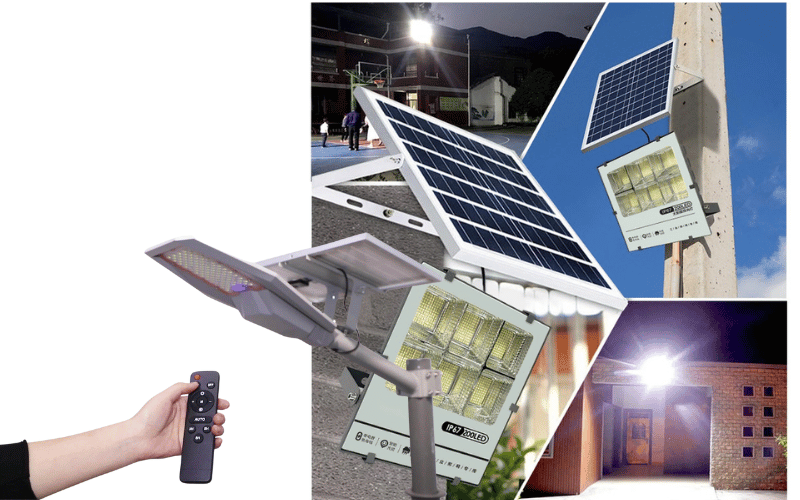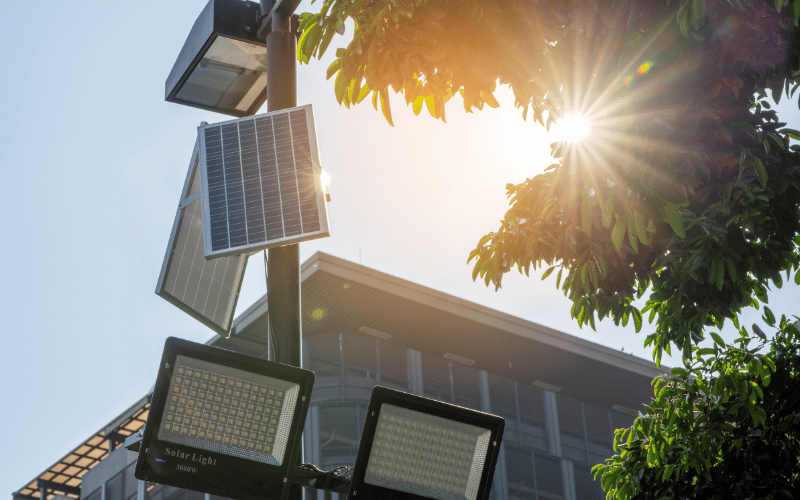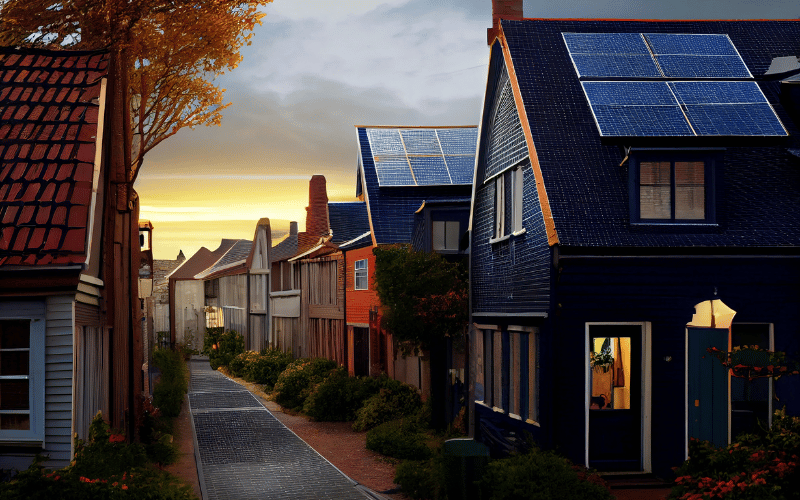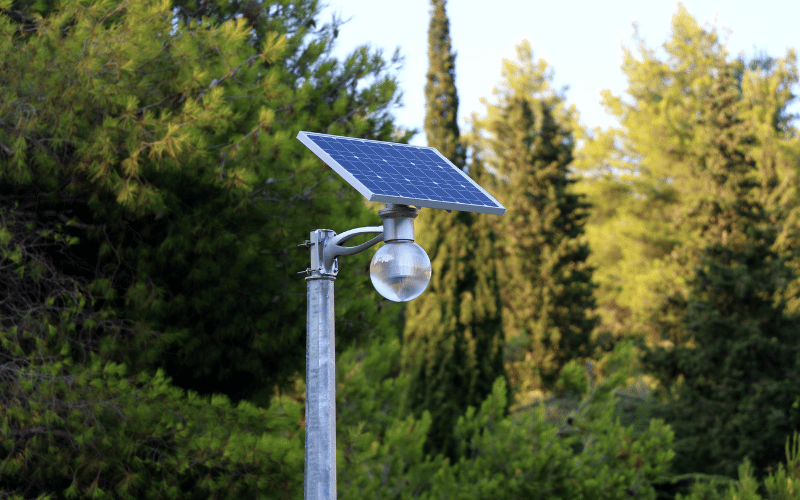Solar lights have become a popular choice for outdoor lighting, offering an eco-friendly, cost-effective, and low-maintenance solution for illuminating gardens, pathways, and driveways. While their functionality may seem straightforward, understanding the role of key components—like the on/off switch—can significantly enhance their performance and longevity. This article explores the practical benefits of the on/off switch, how it impacts energy efficiency, and actionable tips for optimizing and maintaining your solar lights to ensure they meet your specific lighting needs.
Table of Contents
ToggleWhy is There an On/Off Switch on Solar Lights?
Understanding Solar Lights
Solar lights are a go-to solution for outdoor lighting because they are eco-friendly, cost-effective, and simple to install. These lights work by capturing sunlight during the day and converting it into energy stored in a rechargeable battery. At night, this stored energy powers the light, providing illumination without relying on electricity.
The key components of a solar light include:
- Solar Panel: Captures sunlight and converts it into electricity. For example, a high-efficiency panel can generate enough energy to power a 200-lumen garden light for up to 8 hours.
- Rechargeable Battery: Stores the electricity generated by the solar panel. Lithium-ion batteries are common due to their durability and capacity.
- LED Light Bulb: Emits bright, energy-efficient light. A 1000-lumen LED bulb, for instance, can illuminate a 20-foot driveway effectively.
- Light Sensor: Detects darkness and automatically turns the light on at dusk and off at dawn, ensuring hands-free operation.
Different types of solar lights, such as pathway lights, security lights, and decorative lights, may have slight variations in their components, but the basic functionality remains the same.
How Solar Lights Come to Life
The process starts with the solar panel absorbing sunlight during the day. The panel converts sunlight into direct current (DC) electricity, which is stored in the rechargeable battery. Once the sun sets, the light sensor detects the absence of sunlight and activates the LED bulb, using the stored energy to provide illumination.
For example, a solar security light with a motion sensor might stay in a dim mode (200 lumens) until it detects movement, at which point it brightens to 1000 lumens for added visibility.
To ensure optimal performance, place the solar panel in a location that receives at least 6-8 hours of direct sunlight daily. Avoid shaded areas caused by trees, buildings, or other obstructions, as these can reduce charging efficiency. Regularly clean the panel to remove dirt or debris that might block sunlight.
The Role of the Light Switch in Solar Lights
The on/off switch in solar lights serves several practical purposes that enhance their usability and efficiency:
- Energy Conservation: Turning the switch off prevents the light from using stored energy. For instance, if you’re storing the light during winter or don’t need it to operate every night, switching it off helps conserve battery life.
- Manual Control: While most solar lights operate automatically, the switch allows you to manually control when the light operates. This is useful for special occasions or when you want to disable the light temporarily, such as during outdoor movie nights.
- Battery Protection: Keeping the light off during the first 24-48 hours after installation allows the battery to fully charge. A fully charged battery ensures the light operates at peak performance and extends its lifespan.
- Maintenance and Storage: If you need to clean the solar panel or store the light for an extended period, the switch ensures the light remains off, preventing unnecessary energy usage.
Real-World Example: If you’re going on vacation, turning the switch off ensures the battery remains charged and ready for use when you return. Similarly, for solar lights with motion sensors, the switch can help reset the sensor if it’s not functioning properly.
Pro Tip: Always check the switch position during installation. Many solar lights are shipped with the switch in the “off” position to preserve battery life during transit.
By understanding the role of the on/off switch and using it effectively, you can maximize the efficiency, performance, and lifespan of your solar lights while tailoring their operation to your specific needs.
Components and Functions of Solar Lights
Components of Solar Garden Lights
Solar garden lights consist of several essential parts, each designed to ensure effective and reliable operation. Here’s a detailed breakdown of the key components:
- Solar Panel: Captures sunlight and converts it into electricity. For example, a 5-watt solar panel can generate enough energy to power a 300-lumen pathway light for up to 8 hours. High-quality panels are more efficient, even on cloudy days, making them ideal for areas with inconsistent sunlight.
- Rechargeable Battery: Stores the electricity generated by the solar panel. Commonly used batteries include lithium-ion and nickel-metal hydride (NiMH), both known for their durability and capacity. A fully charged lithium-ion battery can power a 1000-lumen security light for an entire night.
- LED Bulb: Provides bright, energy-efficient illumination. LEDs consume minimal power and last significantly longer than traditional bulbs. For instance, a 200-lumen LED bulb is perfect for lighting a 10-foot garden path.
- Light Sensor: Detects changes in ambient light and automatically turns the light on at dusk and off at dawn. This ensures hassle-free operation and energy efficiency.
- On/Off Switch: Allows manual control of the light, giving users flexibility in when and how the light operates. This is especially useful for special occasions or energy conservation.
- Casing and Stake: Protects internal components from weather conditions and allows for easy installation. Look for weather-resistant materials like stainless steel or durable plastic to ensure longevity in outdoor environments.
Different types of solar lights, such as decorative garden lights, motion-activated security lights, and floodlights, may include additional features like motion sensors or adjustable brightness settings.
Importance of the Solar Light Switch
The on/off switch in solar lights plays a crucial role in enhancing their usability and efficiency. Here’s why it matters:
- Energy Management: Turning the switch off prevents the light from using stored energy, which is especially useful during vacations, seasonal storage, or when the light isn’t needed. For example, if you’re storing the light during winter, switching it off ensures the battery remains charged for future use.
- Battery Longevity: Keeping the light off during the first 24-48 hours of installation allows the battery to fully charge. This ensures optimal performance and extends the battery’s lifespan.
- Manual Control: The switch provides flexibility for special occasions, such as outdoor parties, where you may want to control the timing or brightness of the lights manually.
- Maintenance and Storage: During maintenance or storage, the switch ensures the light remains off, preventing unnecessary energy usage and protecting the battery from over-discharge.
Real-World Example: If you’re hosting a backyard barbecue, you can use the switch to turn off decorative lights during the day and turn them on manually in the evening for a customized ambiance.
How the Switch Affects Charging Solar Lights
The position of the on/off switch directly impacts how efficiently solar lights charge. Here’s how it works:
- Switch in the “Off” Position: When the switch is off, the solar panel focuses solely on charging the battery without powering the LED bulb. This is particularly useful during the initial setup or on days with limited sunlight, as it allows the battery to store more energy. For example, turning the switch off during cloudy weather ensures the battery charges as much as possible.
- Switch in the “On” Position: When the switch is on, the light may use stored energy during the night, reducing the amount available for the next evening. This is why it’s recommended to keep the switch off for the first 24-48 hours after installation to ensure the battery reaches full capacity.
Pro Tip: If your solar light isn’t charging properly, check that the switch is in the correct position and ensure the solar panel is clean and free of obstructions. Regular cleaning and proper placement can significantly improve charging efficiency.
By managing the switch effectively and understanding its impact on charging, you can improve the performance and longevity of your solar lights while ensuring they meet your specific lighting needs.
Practical Benefits and Usage of the Switch
Benefits of Using a Light Switch on Solar Lights
The on/off switch on solar lights provides several practical advantages that enhance their usability and energy efficiency. Here’s how:
- Energy Conservation: Turning the switch off prevents the light from using stored energy when it’s not needed. For example, if you’re storing solar lights during winter or don’t require them to operate every night, switching them off helps preserve battery life for future use.
- Battery Optimization: During the first 24-48 hours of installation, keeping the switch off allows the battery to fully charge. A fully charged battery ensures the light operates at maximum efficiency and extends its lifespan. For instance, a fully charged lithium-ion battery can power a 1000-lumen light for up to 10 hours.
- Manual Control: The switch gives you flexibility to decide when the light operates. This is particularly useful for special occasions, such as outdoor parties, where you may want to control the timing or brightness of the lights manually.
- Maintenance and Storage: During maintenance or seasonal storage, the switch ensures the light remains off, preventing unnecessary energy usage and protecting the battery from over-discharge. For example, turning the switch off while cleaning the solar panel ensures the light doesn’t accidentally turn on.
- Customizable Operation: Some solar lights with adjustable brightness or motion-sensing features rely on the switch to toggle between modes. This allows you to control the light’s intensity or functionality based on your specific needs.
Real-World Example: If you’re hosting a backyard barbecue, you can use the switch to turn off decorative lights during the day and turn them on manually in the evening to create a cozy ambiance.
By using the switch effectively, you can maximize the performance and longevity of your solar lights while tailoring their operation to specific situations.
When to Use the Switch on Solar Lights
Knowing when to turn the switch on or off can help you get the most out of your solar lights. Here are some common scenarios:
- During Initial Installation: Keep the switch off for the first 24-48 hours to allow the battery to fully charge. This ensures the light operates at peak performance from the start.
- When Storing the Lights: Turn the switch off before storing solar lights for extended periods, such as during winter months. This prevents the battery from draining unnecessarily and ensures it’s ready for use when you take the lights out of storage.
- For Energy Savings: If you don’t need the light to operate every night, such as during vacations or in areas with minimal use, turn the switch off to conserve energy and extend battery life. For example, turning off pathway lights in a rarely used garden can save energy for when they’re needed most.
- For Maintenance: Turn the switch off when cleaning the solar panel or performing other maintenance tasks. This ensures the light doesn’t accidentally turn on while you’re working, which could drain the battery unnecessarily.
- For Special Occasions: Use the switch to manually control the light for specific events or gatherings. For instance, you can adjust the brightness or timing of decorative lights to match the mood of an evening party.
Pro Tip: Always check the switch position if your solar light isn’t working as expected. Many lights are shipped with the switch in the “off” position to preserve battery life during transit. Additionally, ensure the solar panel is clean and positioned to receive direct sunlight for optimal charging.
By understanding when and how to use the switch, you can ensure your solar lights remain efficient, reliable, and perfectly suited to your outdoor lighting needs.
Optimizing and Maintaining Solar Lights
Optimizing Solar Light Performance
To get the best results from your solar lights, focus on proper placement, regular cleaning, and efficient usage. Here are some actionable tips:
- Positioning Matters: Place solar lights in areas that receive direct sunlight for at least 6-8 hours daily. For example, position pathway lights at least 2 feet apart to ensure even illumination without shadows. Avoid shaded spots caused by trees, buildings, or fences, as these reduce the energy the solar panel can absorb.
- Angle the Solar Panel: Adjust the panel to face the sun directly, especially during winter months when sunlight is weaker. A tilt of 30-45 degrees often works best. In areas with frequent overcast days, consider solar lights with larger panels or higher-capacity batteries for better performance.
- Use Energy-Saving Features: Many solar lights come with dim modes or motion sensors. For instance, a motion-activated security light can stay in dim mode (200 lumens) and brighten to 1000 lumens when movement is detected, conserving energy while providing bright illumination when needed.
- Combine Lumen Levels: For layered lighting, use low-lumen lights (50-100 lumens) for decorative purposes and high-lumen lights (500+ lumens) for functional or security needs. This approach balances aesthetics and practicality.
By optimizing placement and using built-in features, you can enhance the performance and efficiency of your solar lights.
How to Extend the Life of Solar Lights
Proper maintenance ensures your solar lights last longer and perform consistently. Here’s how:
- Clean the Solar Panel Regularly: Dust, dirt, and debris can block sunlight and reduce charging efficiency. Clean the panel every 2-3 months using a soft cloth and mild soap. In coastal areas, rinse the panel with fresh water monthly to prevent salt buildup and corrosion.
- Protect Against Weather Damage: Choose lights with weather-resistant materials, especially if they’re exposed to rain, snow, or extreme heat. For harsh winters, consider storing the lights indoors to prevent battery damage.
- Check and Replace Batteries: Over time, rechargeable batteries lose their capacity. Replace them every 1-2 years to maintain optimal performance. For example, if your light dims prematurely, it may be time to replace the battery with a compatible lithium-ion or NiMH option.
- Inspect for Damage: Periodically check for cracks, loose connections, or water damage. Address issues promptly to prevent further deterioration. For instance, a cracked casing can allow moisture to seep in, damaging internal components.
Consistent care and timely replacements can significantly extend the lifespan of your solar lights.
Understanding Battery and Sensor Functions
Batteries and sensors are critical components that work together to power solar lights effectively. Here’s what you need to know:
- Rechargeable Batteries: These store the energy generated by the solar panel during the day. Common types include lithium-ion and NiMH batteries, both known for their durability and capacity. For example, a fully charged lithium-ion battery can power a 1000-lumen light for up to 10 hours.
- Light Sensors: These detect ambient light levels and automatically turn the light on at dusk and off at dawn. If your light doesn’t turn on at night, the sensor may be blocked by dirt or facing an artificial light source. Clean the sensor or reposition the light to resolve the issue.
- Motion Sensors: Found in security lights, these activate the light only when movement is detected. For instance, a motion sensor can conserve energy by keeping the light off until it’s needed, such as when someone approaches your driveway.
Understanding how these components function helps you troubleshoot issues and maintain your solar lights effectively.
Best Practices for Charging Solar Lights
Proper charging is essential for consistent performance and long battery life. Follow these best practices:
- Initial Charging: When installing new solar lights, keep the switch off and allow the battery to charge for 24-48 hours in direct sunlight. This ensures the battery reaches full capacity and the light operates at peak performance.
- Daily Sunlight Exposure: Place the lights in areas with unobstructed sunlight. Even partial shading can reduce charging efficiency and affect nighttime performance. For example, avoid placing lights under trees or near tall structures.
- Avoid Artificial Light: Keep solar panels away from artificial light sources, such as streetlights or porch lights, which can interfere with the light sensor and prevent proper charging.
- Seasonal Adjustments: During winter, reposition the lights to maximize exposure to the lower-angle sunlight. Tilt the solar panel at a 45-degree angle to capture more sunlight and prevent snow buildup. Clean the panels more frequently to remove dirt, snow, or ice.
Pro Tip: If your solar light isn’t charging properly, check for dirt on the panel, ensure the switch is in the correct position, and verify that the light is placed in direct sunlight.
By following these best practices, you can ensure your solar lights charge efficiently and provide reliable illumination for years to come.
Frequently Asked Questions
Q: Why do solar lights have an on/off switch?
A: The on/off switch on solar lights lets you manually control their operation. This is especially useful for conserving battery power when the lights aren’t needed, such as during the day or while in storage. Turning the switch off also allows the battery to focus solely on charging.
Q: How does the light sensor work in solar-powered lighting?
A: The light sensor detects ambient light levels to control the lights automatically. When it senses darkness, it turns the lights on to provide illumination. During daylight, the sensor keeps the lights off, allowing the solar panel to recharge the battery.
Q: What happens if the solar light doesn’t turn on?
A: If your solar light doesn’t turn on, check for common issues like insufficient sunlight, a dirty solar panel, or a depleted battery. Clean the solar panel, ensure the switch is in the “on” position, and replace the battery if needed.
Q: How can I extend the life of my solar lights?
A: To extend the life of your solar lights, clean the solar panel regularly to maximize sunlight absorption. Replace the rechargeable batteries as needed to maintain performance. During storage or long periods of non-use, turn the switch off to conserve battery life.
Q: Can I manually turn on solar garden lights?
A: Yes, you can manually turn on solar garden lights using the on/off switch. This feature is handy for special occasions or during cloudy days when the solar panel may not fully charge the battery.
Q: Will solar lights charge during overcast days?
A: Solar lights can charge during overcast days, but the efficiency is lower compared to sunny days. The solar panel will still collect some energy, but it may take longer to fully recharge the battery.
Q: What should I do if there is an issue with my solar light?
A: If your solar light isn’t working, first check that the switch is in the “on” position. Clean the solar panel to remove dirt or debris, and ensure it’s placed in direct sunlight. If the issue persists, replace the rechargeable battery.
Q: How do solar lights provide illumination at night?
A: Solar lights illuminate at night using a light sensor that detects darkness. Once it’s dark, the sensor activates the LED bulb, which uses stored energy from the rechargeable battery to light up your outdoor spaces.
Concluding Summary
Solar lights are a versatile and sustainable lighting solution, but their efficiency and lifespan depend on proper usage and maintenance. By understanding the role of the on/off switch, optimizing placement, and following best practices for charging and care, you can maximize their performance while tailoring them to your unique requirements. Whether it’s conserving energy during storage, ensuring optimal battery life, or troubleshooting common issues, these insights empower you to get the most out of your solar lights for years to come.





